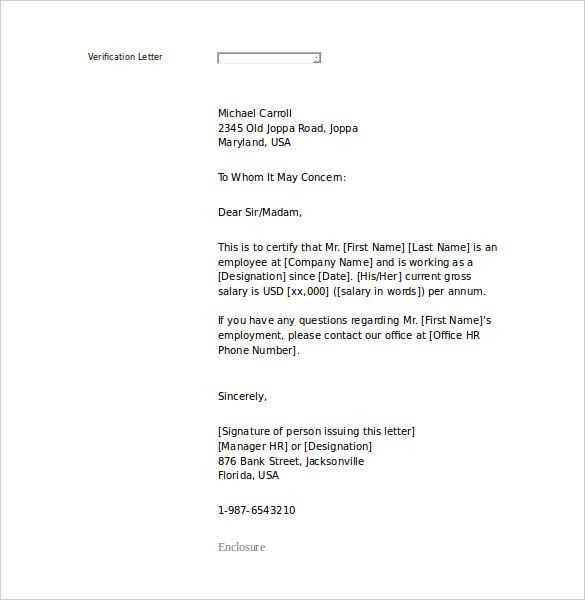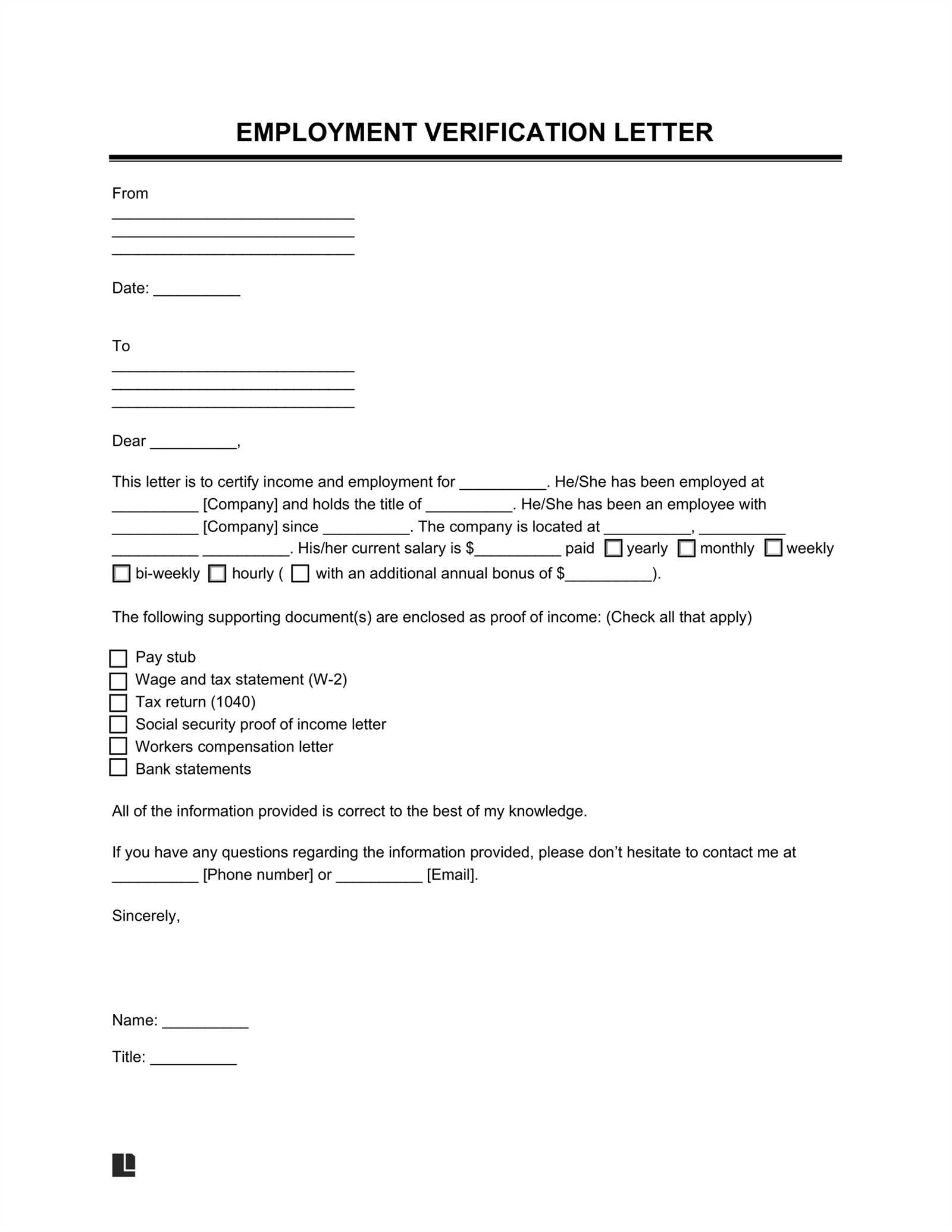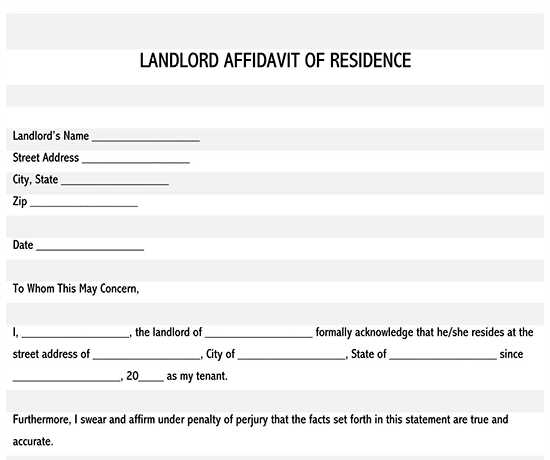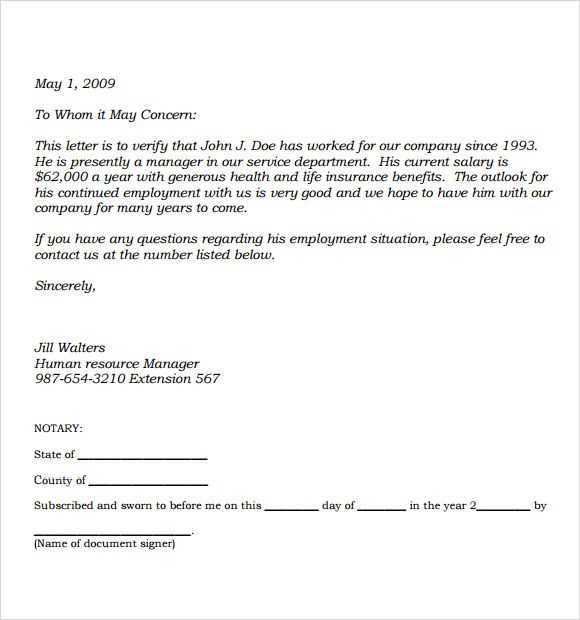Residence verification letter template

For a smooth and accurate residence verification process, use this simple template to confirm someone’s place of residence. It provides a clear format that helps streamline the confirmation of housing details required by various authorities or institutions.
Start with the name of the person providing the verification, followed by the specific address being verified. Be sure to mention the length of residence at that location, and include the purpose of the verification. This keeps the letter focused and relevant.
Ensure the letter is signed by someone with authority, such as a landlord or property manager, and that contact information is included for any follow-up questions. This builds credibility and makes the process smoother for anyone reviewing the letter.
Having a template like this on hand can save you time when a residence verification is needed. Adjust the details according to the specific requirements of the requesting party to ensure the letter meets their needs.
Here’s the revised version:
Include the full name of the resident and the exact address. Add the dates they resided there and identify the person verifying the residence. Ensure to list the contact details of the verifier for validation purposes.
Details to Include
- Full name of the resident.
- Complete address of the residence.
- Start and end dates of residence.
- Verifier’s name and contact details.
Formatting Tips
- Present information in a clear and concise manner.
- Make sure the document is signed by the verifier for authenticity.
- Avoid irrelevant information or overly complex wording.
- Residence Verification Letter Template
A residence verification letter is a formal document used to confirm an individual’s current address. This letter can be requested for various purposes, including applying for loans, educational programs, or government services. Here’s a basic template to guide you when drafting one.
Template for Residence Verification Letter
[Your Name]
[Your Address]
[City, State, ZIP Code]
[Phone Number]
[Email Address]
[Date]
To Whom It May Concern,
I am writing to verify the residence of [Name of Resident], who currently resides at the address listed below. The following details are provided for confirmation:
Resident’s Name: [Full Name]
Current Address: [Complete Address, including apartment number, if applicable]
Duration of Residence: [How long the resident has lived at the address]
If you require additional information, feel free to contact me at the provided phone number or email address.
Sincerely,
[Your Full Name]
[Your Title or Position, if applicable]
How to Use the Template
Fill in the specific details of the resident and your contact information. Ensure the letter includes a clear mention of the duration of residence. This will confirm the authenticity of the address provided. Keep the tone professional and direct to avoid unnecessary details.
Begin by including the letter’s date at the top. This provides a reference point for both the sender and the recipient.
Next, add the sender’s name, address, and contact details. This information should be placed in the top-left corner or aligned to the right, depending on the format you prefer. If you’re writing on behalf of an institution, make sure to include the name of the institution and any relevant official titles.
After the sender’s details, include the recipient’s name and address. Be sure to use the full name and title of the recipient, especially if they are a government official or business representative.
In the opening paragraph, state the purpose of the letter clearly. Mention the individual whose residence you are verifying and their current address. This section should provide a straightforward confirmation, with no unnecessary details.
Next, add a few details regarding the relationship between the sender and the individual. For example, state whether the sender is a landlord, roommate, or employer and specify how long they have known the individual. This gives context to the verification.
Conclude the letter with a polite and direct closing statement, reaffirming the accuracy of the information provided. You can offer to answer any additional questions or provide further documentation if necessary.
Finish with a formal sign-off, followed by the sender’s signature, name, and title. If applicable, include any required official seals or stamps to add credibility to the verification.
Ensure that the letter includes the full name of the resident. This will clarify who the letter is confirming residence for.
Provide the exact address where the person resides, including apartment number or unit if applicable. Make sure the address is current and accurate.
State the dates of residence. Include both the start and end dates of the residency to give a clear timeline. If the person still lives there, specify that the residency is ongoing.
Residence Confirmation

Clearly confirm that the individual is living at the specified address. This should be an unequivocal statement without ambiguity.
Additional Details
If needed, include details about the nature of the residence. For example, whether the person rents, owns, or stays with family. These details help give context to the type of accommodation.
Don’t forget to add the contact information of the person providing the confirmation. Include their full name, position (if applicable), and contact details, such as phone number or email.
Finally, include the date the letter was written and the signature of the person confirming the information. These details validate the authenticity of the document.
Common Scenarios Requiring a Verification Letter
A residence verification letter is necessary in several situations to confirm the residency status of an individual. Here are some common instances when such a letter is needed:
- Rental Applications: Many landlords or property managers ask for a residence verification letter to confirm your current address and rental history before approving an application.
- Immigration Purposes: Government agencies or immigration offices often require proof of residence when processing visas, residency applications, or citizenship requests.
- Loan or Mortgage Applications: Banks and lending institutions request a residence verification letter as part of their process to ensure you have a stable living arrangement.
- University Admissions: Colleges may request this letter to confirm your address for residency-based admissions or scholarship eligibility.
- Health Insurance: Some health insurance providers may require proof of your current address when verifying your coverage or eligibility for certain plans.
- Tax Filing: Local tax authorities might ask for a residence verification letter to confirm your residence for tax purposes or to apply for specific deductions or exemptions.
- Proof of Address for Government Services: Access to government assistance programs, voting registration, or social services may require documentation of your current residence.
Make sure to include all necessary details, such as the duration of residence and any supporting documents, to ensure the letter fulfills its intended purpose.
When preparing a residence verification letter, ensure it complies with relevant legal requirements. The letter should clearly state the relationship between the writer and the individual whose residence is being verified, along with supporting evidence of the person’s residence, such as utility bills or lease agreements. This guarantees the letter serves its intended purpose in situations requiring legal verification.
Key Legal Aspects to Address

Verify the accuracy of all information provided. Including false or misleading details can lead to legal repercussions. The letter should also be signed by a credible individual with the authority to confirm the residence, such as a landlord or property manager.
Required Documentation
Depending on the jurisdiction, some institutions may require specific documents to accompany the verification letter, such as government-issued identification or a signed lease agreement. Always check the exact requirements to avoid delays or legal challenges.
| Document | Description | Legal Requirement |
|---|---|---|
| Government ID | Proof of identity for the person being verified | Usually required for authenticity |
| Lease Agreement | Shows the individual’s legal residency at the address | Commonly requested by most institutions |
| Utility Bills | Demonstrates continuous residence at the address | Often requested to confirm long-term residency |
Maintain a clear and simple layout to ensure readability. Use standard fonts such as Arial or Times New Roman, size 12, to keep the letter professional and legible. Avoid using decorative fonts that could distract from the message.
Structure of the Letter
Organize the letter with a formal header that includes the name of the person verifying the residence, the address of the property, and the contact details. Follow this with a concise body that includes the purpose of the letter and the relevant details about the residence, such as the tenant’s name, length of residence, and the nature of the arrangement.
Contact Information and Signatures
Conclude the letter with a clear contact section. Include phone numbers and email addresses for follow-up. A handwritten signature can add a personal touch, but it’s not mandatory if the letter is submitted electronically.
| Section | Details |
|---|---|
| Header | Include the full address of the property and contact information for the verifier. |
| Body | State the purpose of the letter, the duration of the residence, and any specific details about the arrangement. |
| Closing | Finish with contact information for follow-up, and optionally, a handwritten signature. |
Tips for Customizing a Verification Letter for Specific Needs
Tailor the letter to meet the specific requirements of the requesting party. For instance, if the letter is for a financial institution, include details about the tenant’s payment history and current rent status. For immigration purposes, focus on the length of residence and the applicant’s compliance with local regulations.
Be Clear and Direct
Avoid ambiguity. Clearly state the nature of the residence verification, such as the duration of occupancy, the type of property, and any other relevant factors. For housing authorities, mention whether the individual is renting, owning, or living with family or friends. This helps avoid confusion or back-and-forth inquiries.
Include Supporting Documentation

Attach any relevant documents that may strengthen the verification, such as utility bills or lease agreements. If the letter needs to confirm a specific time frame, ensure that you reference dates accurately. This can add credibility and reduce the likelihood of delays.
Always tailor your language and details to the specific context. Customizing the verification letter to the recipient’s needs will help ensure the process moves along smoothly and without unnecessary backlogs.
Residence Verification Letter Template
Ensure your letter includes specific details such as the full name of the person whose residence is being verified, the address, and the dates of their residence at that location. The letter should also clearly state the relationship between the verifier and the person, and whether the person is currently residing at the address.
Use straightforward language and maintain a formal tone. Include a request for any necessary documentation if needed, such as a utility bill or lease agreement, to support the verification process. Conclude by providing contact information for follow-up inquiries.
Remember, the letter must be signed by someone with authority to confirm the details provided, such as a landlord, property manager, or employer. Ensure that the document is clear and concise to avoid confusion during review.